MARIANI’S
Virtual
Gourmet
November 6,
2022
NEWSLETTER
Founded in 1996
ARCHIVE
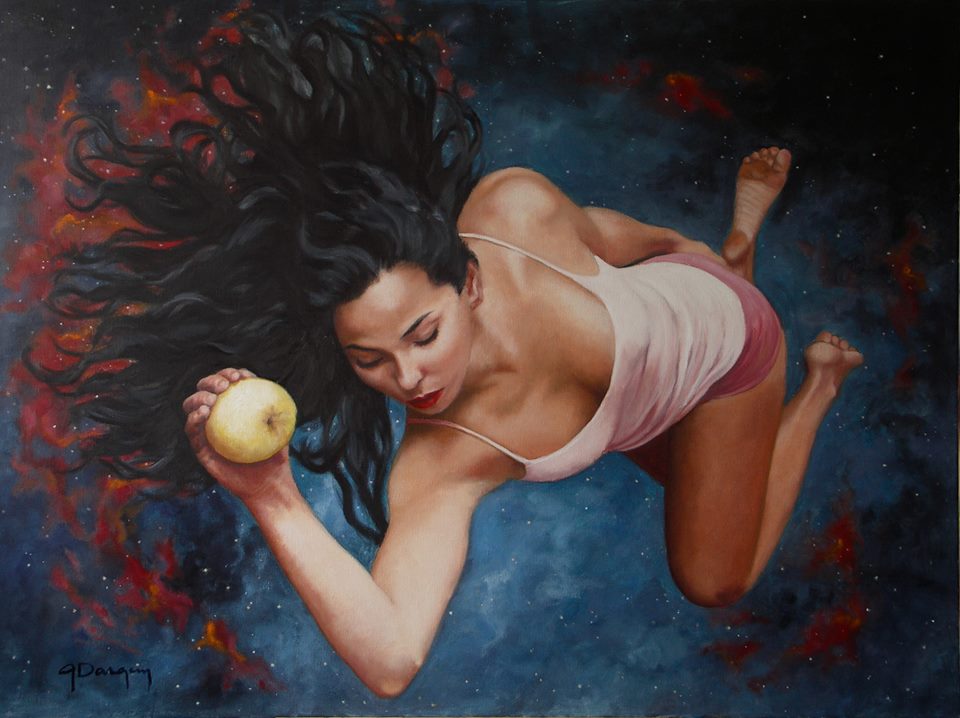
"Hespere
and
the Golden Apple" by Galina Dargery (2016)
IN THIS ISSUE
OLD SAYBROOK GAINS
A NEW CULINARY STAR
By John Mariani
NEW YORK CORNER
JALAO
By John Mariani
ANOTHER VERMEER
CHAPTER FORTY-FOUR
By John Mariani
NOTES FROM THE WINE CELLAR
FOURTH EDITION OF THE COMPLETE BORDEAUX
By John Mariani
❖❖❖
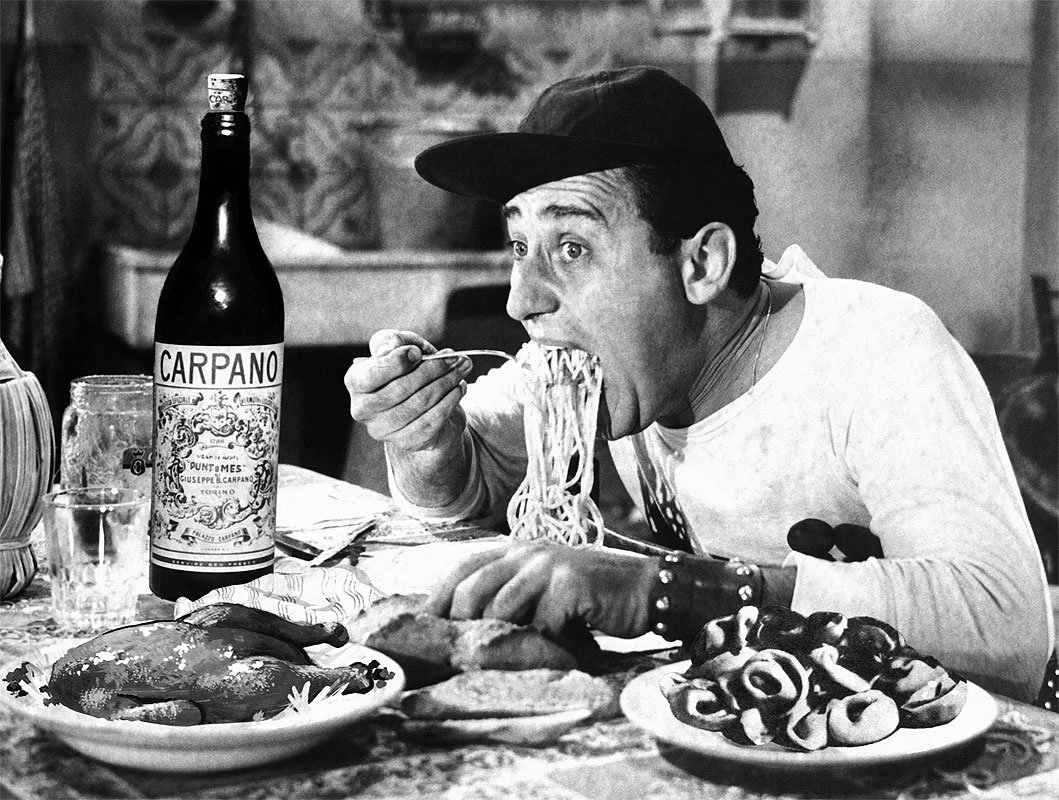
IMPORTANT ANNOUNCEMENT! THERE WILL BE NO EDITION OF MARIANI'S VIRTUAL GOURMET NEWSLETTER NEXT WEEK (NOV. 13) BECAUSE MARIANI WILL BE DINING AROUND IN ITALY FOR HIS READERS' EDIFICATION.
❖❖❖
 Prof. Christina
Carlson on WHO, ME?
New Revelations About Geoffrey
Chaucer's Rape Allegation. Go to: WVOX.com.
The episode will also be archived at: almostgolden.
Prof. Christina
Carlson on WHO, ME?
New Revelations About Geoffrey
Chaucer's Rape Allegation. Go to: WVOX.com.
The episode will also be archived at: almostgolden.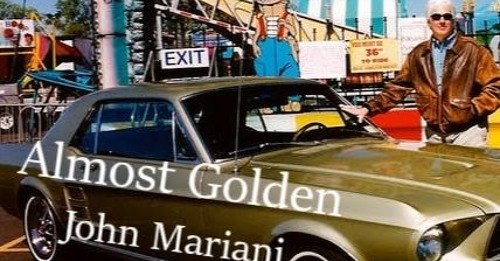
❖❖❖
OLD SAYBROOK GAINS
A NEW CULINARY STAR
By John Mariani
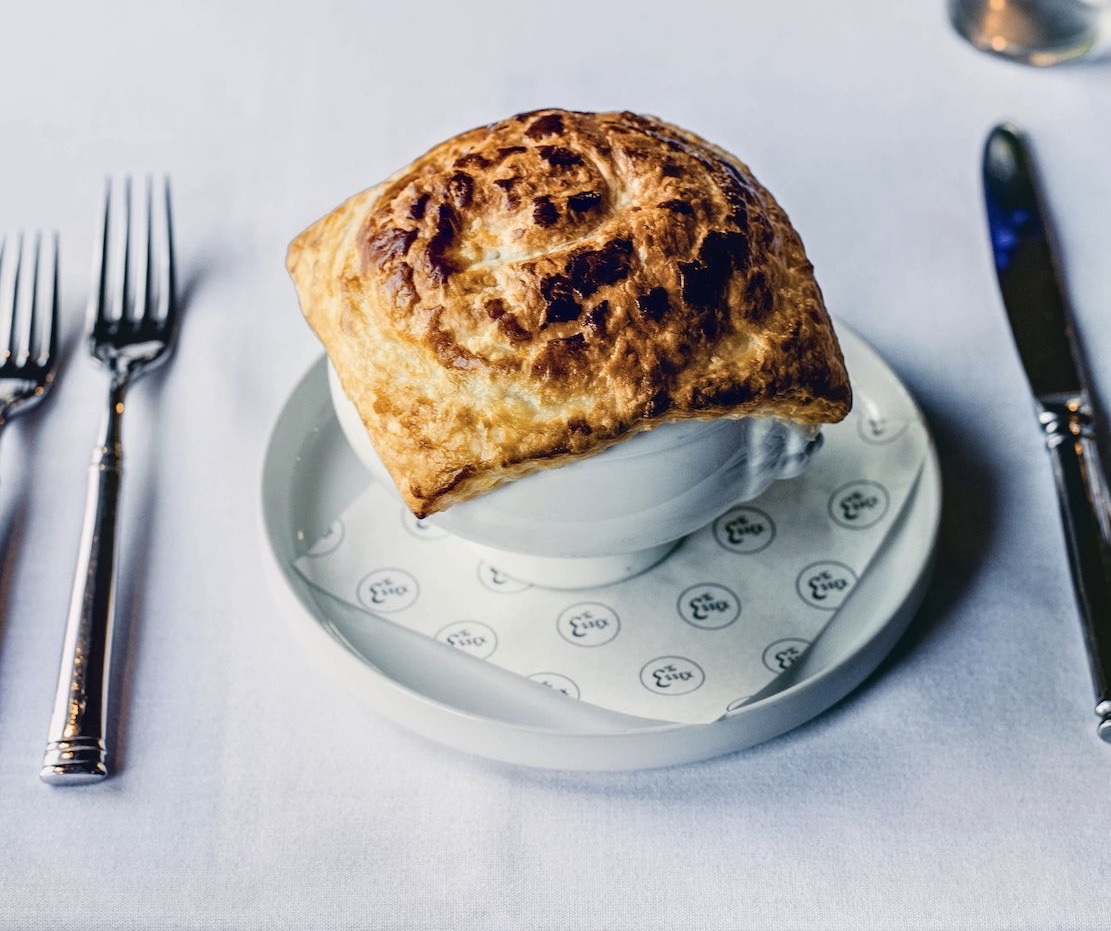
Old Saybrook, which
is principally one long Main Street, dates back
to 1624, with Dutch origins, then as Saybrook
Colony in 1635 it came under English rule. In
1701 the Collegiate School of Connecticut was
chartered there, before moving to New Haven a
decade later to become Yale University. So, the
town clearly has much historical interest for
anyone traveling up the New England coastline.
In 2009 the town fathers converted the old
town hall to the Katharine Hepburn Cultural Arts
Center and Theater.
Kate lived in nearby Fenwick, and there’s a
room named after her at the 135-year-old Saybrook
Point Inn and Spa, which has been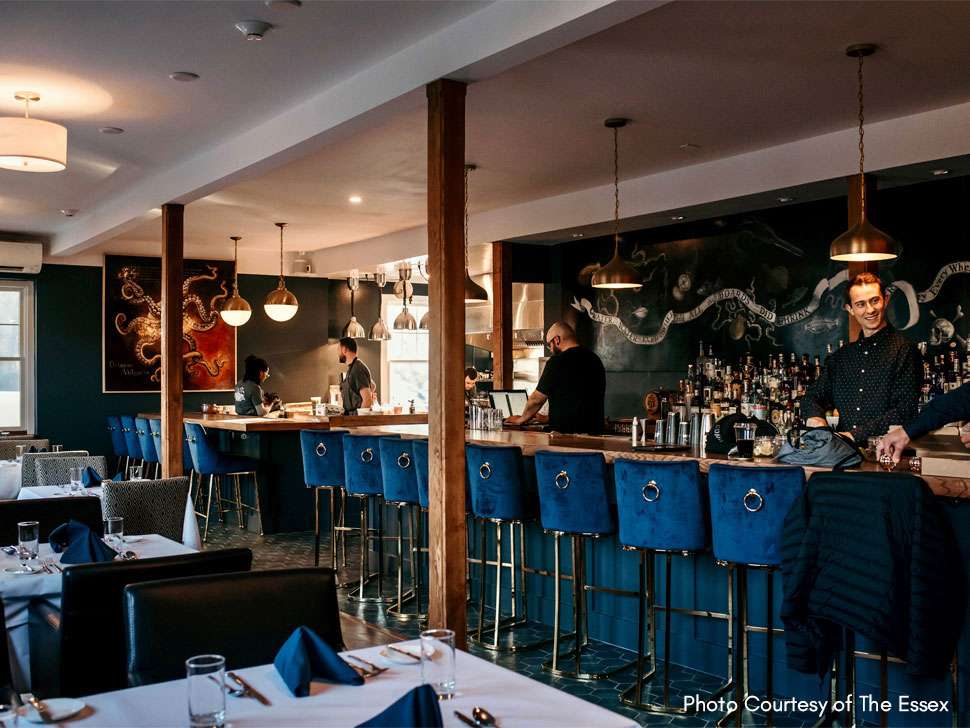 restored and expanded with a main house, a large
guest house across the road and a marina, all of
them set on the edge of the fast-running Connecticut
River and Long Island Sound. The Inn
once had a reputation as refuge for show biz stars
and mobsters, thereby lending the Inn a rakish
glamour. It
also has a fine restaurant on the premises, called
Fresh Salt.
restored and expanded with a main house, a large
guest house across the road and a marina, all of
them set on the edge of the fast-running Connecticut
River and Long Island Sound. The Inn
once had a reputation as refuge for show biz stars
and mobsters, thereby lending the Inn a rakish
glamour. It
also has a fine restaurant on the premises, called
Fresh Salt.
There’s not been much else in the way of
restaurants to draw out-of-towners to Old Saybrook
until recently. With the opening of The Essex
(relocated this year from the town of Centerbrook
to the north), it now has a chef and restaurant
that would definitely be worth a drive from New
Haven, about a half-hour away, with Providence 75
miles north. Here, in a warmly lighted
cottage-like building with 42 seats off Main
Street, Colt Taylor (his wife Katey selected the
100 wines on the list) is among those New England
chefs who have a strong devotion to the traditions
of seafood, vegetables and meats appended with the
kinds of ideas and spices long ago drawn to such a
great trading, seafaring region.
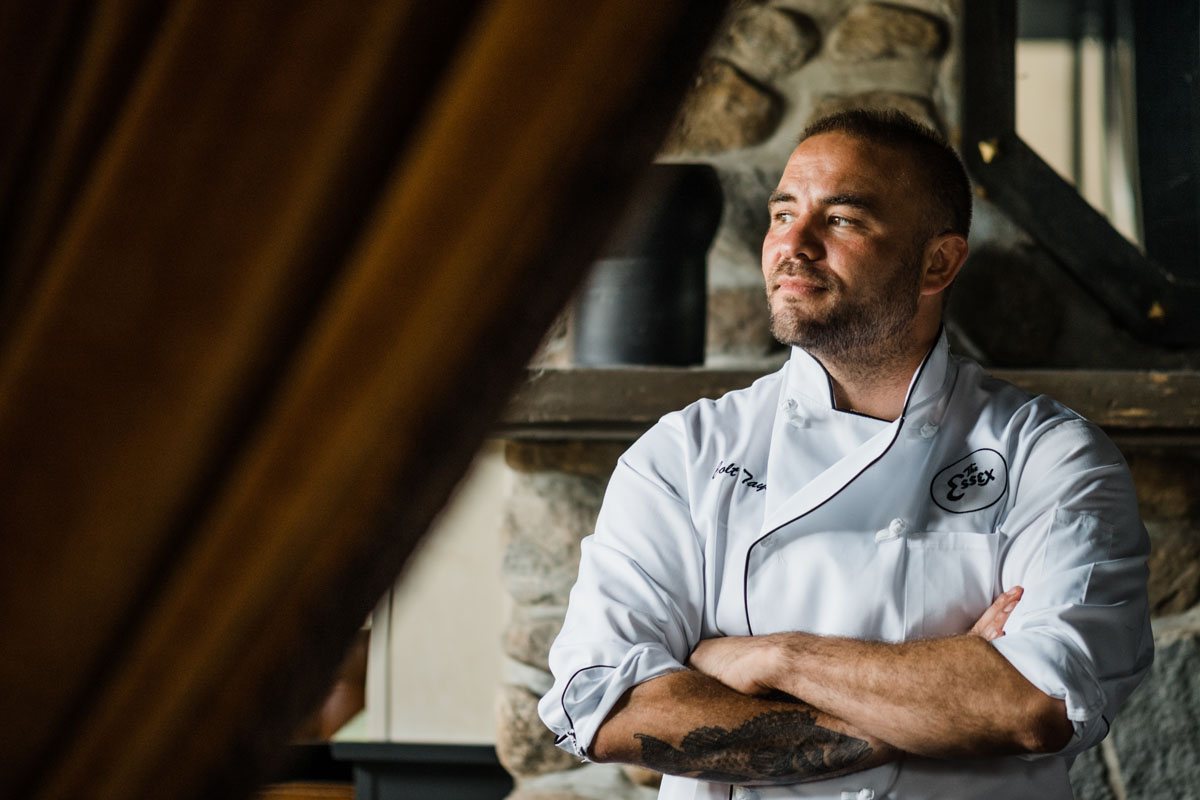 The
room could hardly be cozier, and everyone looks
like a regular in their Orvis sweaters and
Abercrombie & Fitch barn coats. The tables are
lovingly set with white cloths and candles and a
single flower, the lighting is good, the noise
level not bad. There’s a bar as you enter and a
snug open kitchen where Taylor has installed a
young crew, for some their first cooking job.
There’s a chef’s tasting menu of five courses at a
very reasonable $85 and seven at $105, as well as
a la carte, and portions are generous.
The
room could hardly be cozier, and everyone looks
like a regular in their Orvis sweaters and
Abercrombie & Fitch barn coats. The tables are
lovingly set with white cloths and candles and a
single flower, the lighting is good, the noise
level not bad. There’s a bar as you enter and a
snug open kitchen where Taylor has installed a
young crew, for some their first cooking job.
There’s a chef’s tasting menu of five courses at a
very reasonable $85 and seven at $105, as well as
a la carte, and portions are generous.
An
unexpected and unusually delicious canapé
arrived of lustrous bigeye
tuna glossed with olive oil and American caviar
over cucumber
rounds. Also, a small cup of
not-very-appealing-looking broth turned out to be
truly delicious—a much reduced lobster and beef pot au feu.
The most
delightful of starters is the sweet, creamy devil
crab pithivier,
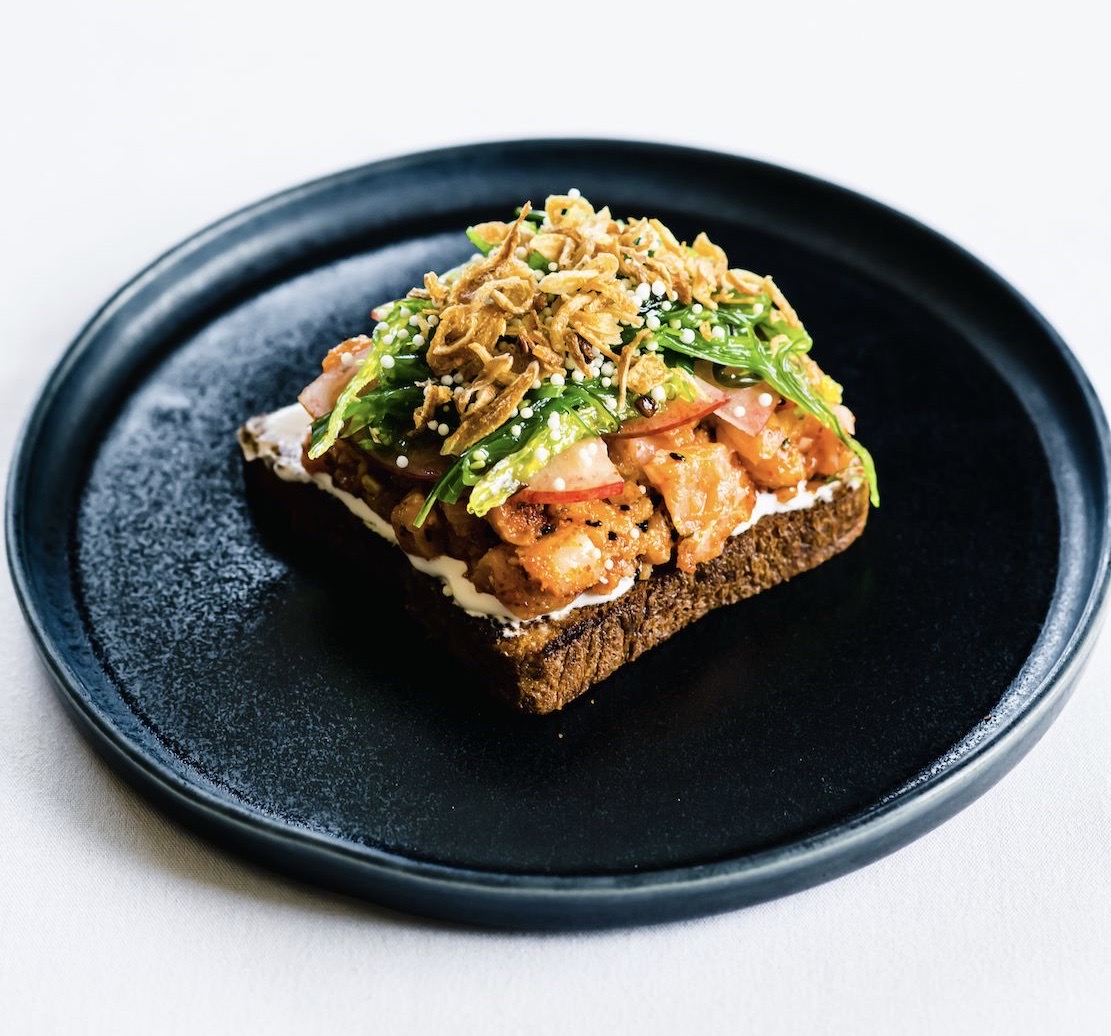 with lobster, spicy
pepper mustard and almond ($19). A third amuse was
a simple potato chip swabbed with Dijon mustard,
pickled ginger and a crab salad that sparked the
palate. Rich in seafood, the menu also features
Ōra King salmon belly ($18), well fatted, with
wakame kelp, crème fraîche, stone fruit, togarashi
seasoning and a Japanese milk bread similar to
brioche.
with lobster, spicy
pepper mustard and almond ($19). A third amuse was
a simple potato chip swabbed with Dijon mustard,
pickled ginger and a crab salad that sparked the
palate. Rich in seafood, the menu also features
Ōra King salmon belly ($18), well fatted, with
wakame kelp, crème fraîche, stone fruit, togarashi
seasoning and a Japanese milk bread similar to
brioche.
The main courses began with delicate
Hawaiian walu white tuna crudo ($19) with golden
rice, black sesame, wasabi, espellete pepper,
apple and radish that was a medley of textures and
mild-hot and spicy flavors. This is
New England,
so by all means have the clam chowder
($19), pumped up with sugar kelp, dulse and kombu
kelp that add measurably to the levels of briny
flavor to a dish that by tradition can often be
bland. Silky sablefish is seared and marinated
with miso, and XO-sauced creamed French lentils,
bok choy and
citrus salad of pickled 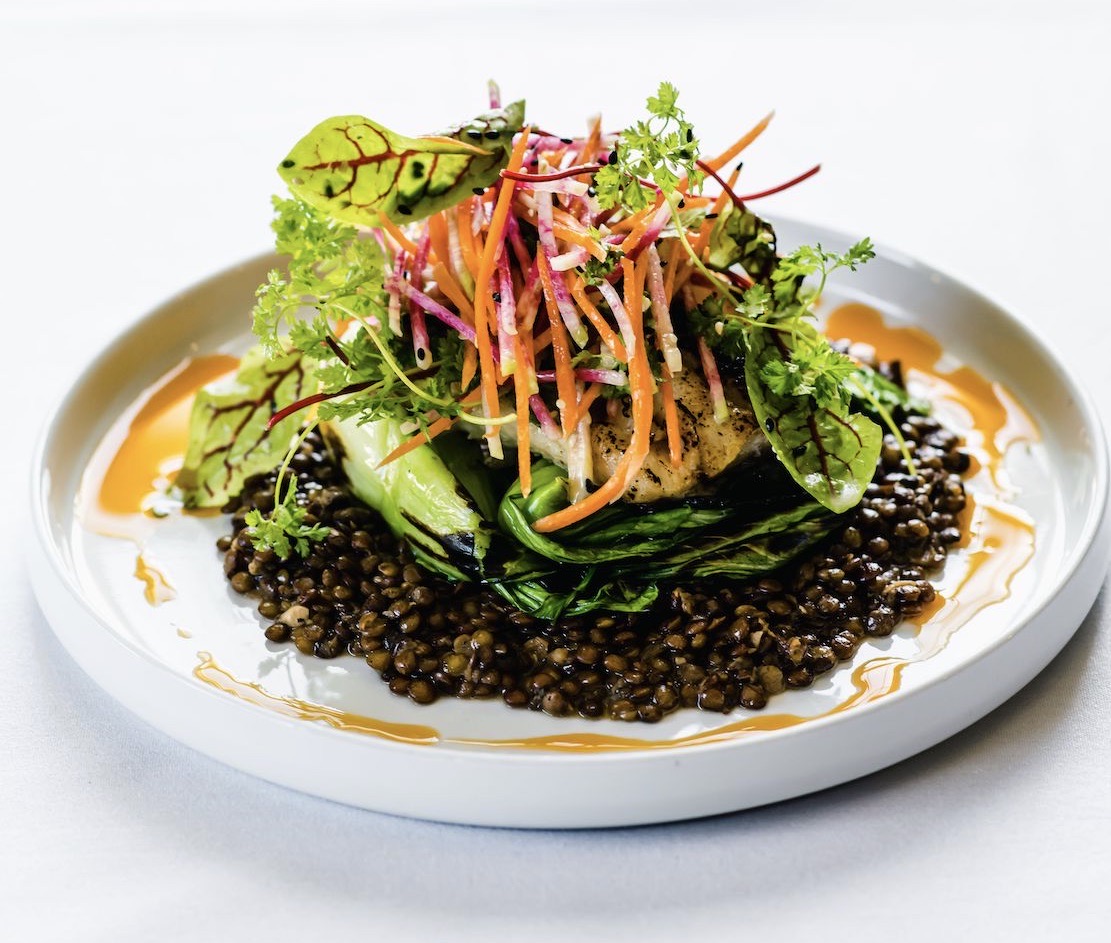 herbs,
whose flavors and textures all come
together wonderfully ($38). It is all a delicate
balancing act.
herbs,
whose flavors and textures all come
together wonderfully ($38). It is all a delicate
balancing act.
This is autumn and a hearty dish indeed is
the halibut and lobster bourride with
mussels,
the zestiness of lemon, Georgia candy roaster
squash and sourdough ($38).
Of the three desserts I sampled (all $10) ,
I’d recommend the creamy chocolate budino or
the intense chocolate s’mores tart over a
“Birthday cake” that really didn’t taste much
different from the run-of-the-mill variety.
Taylor is a chef of strong opinions, based
on sustainability and environmental concerns,
though his dependence on so many ingredients not from
the New England farms and waters, like Pacific
Northwest salmon, New Zealand salmon, caviar from
North Carolina, wagyu from Idaho, and meat
from Australia makes it seem disingenuous for his
website’s to claim that he showcases the provender
of the Connecticut River Valley.
Nevertheless, Taylor is a major
talent and quite obviously buys high quality
ingredients and treats them with a simple grace
and intelligence that have obviously made an
impression on guests who can taste the
distinction.
Open
for dinner Tues.-Sat.
JALAO NYC
2420 Amsterdam Avenue
929-688-4684
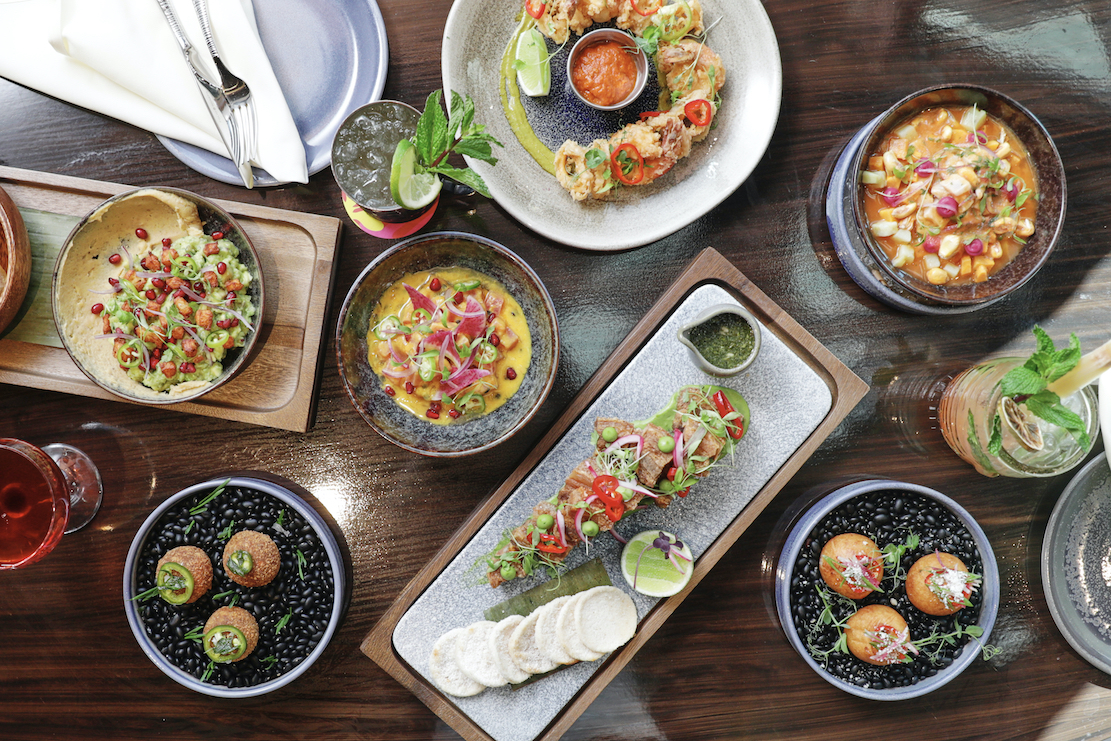
As anyone (of the few, apparently) who
saw last year’s movie In the
Heights knows, the Washington Heights
neighborhood at the northern tip of Manhattan is
a vibrant section with the moniker of Little
Dominican Republic. Until now, restaurants
featuring the food of that Caribbean island have
been modest and few in number, but the dazzling,
brand new Jalao NYC ups the ante considerably,
for style, sophistication and just plain fun.
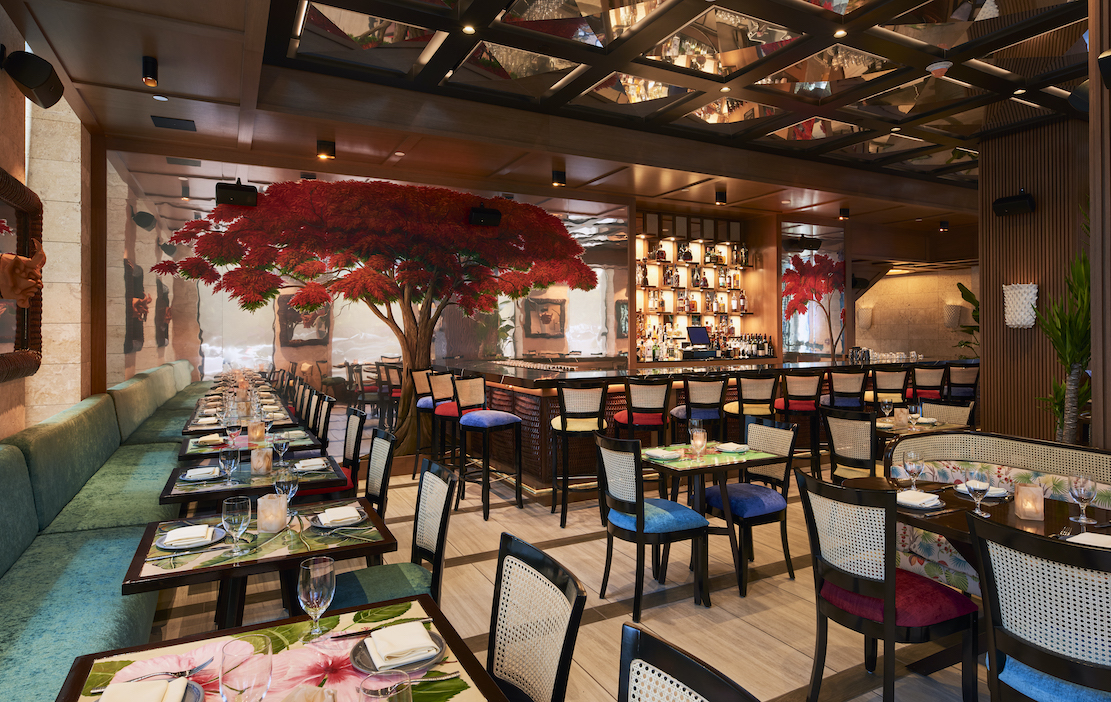 This
is the first offshoot of a popular Santo Domingo
restaurant of the same name, opened in 2016 by
Antonio Espaillat and his wife Montserrat (whose
company also owns 50 radio and TV stations in the
DR), along with operating partner and consulting
chef Richard Sandoval and Executive Chef Noemi Guzman. At Jalao
NY the chef is Wilmer
Chuquillanqui, Peruvian by birth, and Radhames
Corporan is the manager.
This
is the first offshoot of a popular Santo Domingo
restaurant of the same name, opened in 2016 by
Antonio Espaillat and his wife Montserrat (whose
company also owns 50 radio and TV stations in the
DR), along with operating partner and consulting
chef Richard Sandoval and Executive Chef Noemi Guzman. At Jalao
NY the chef is Wilmer
Chuquillanqui, Peruvian by birth, and Radhames
Corporan is the manager.
Located in the new Radio Hotel, Jalao NYC
is more glamorous than its Santo Domingo original,
with dazzling, rich colors everywhere, Carnival
masks, a palm motif, rattan and upholstered
booths, beautiful painted tables and a glass wall
with a brilliant, leafy Flamboyant Tree painted on
it, a brightly lit bar and, outside, when the
weather allows, a huge space for cocktails, dining
and music. In
the dining room, unobtrusive Caribbean music plays
softly.
The menu is of good size, but not
bewilderingly so, sectioned off into bocaditos (starters),
Caribbean-style ceviche, 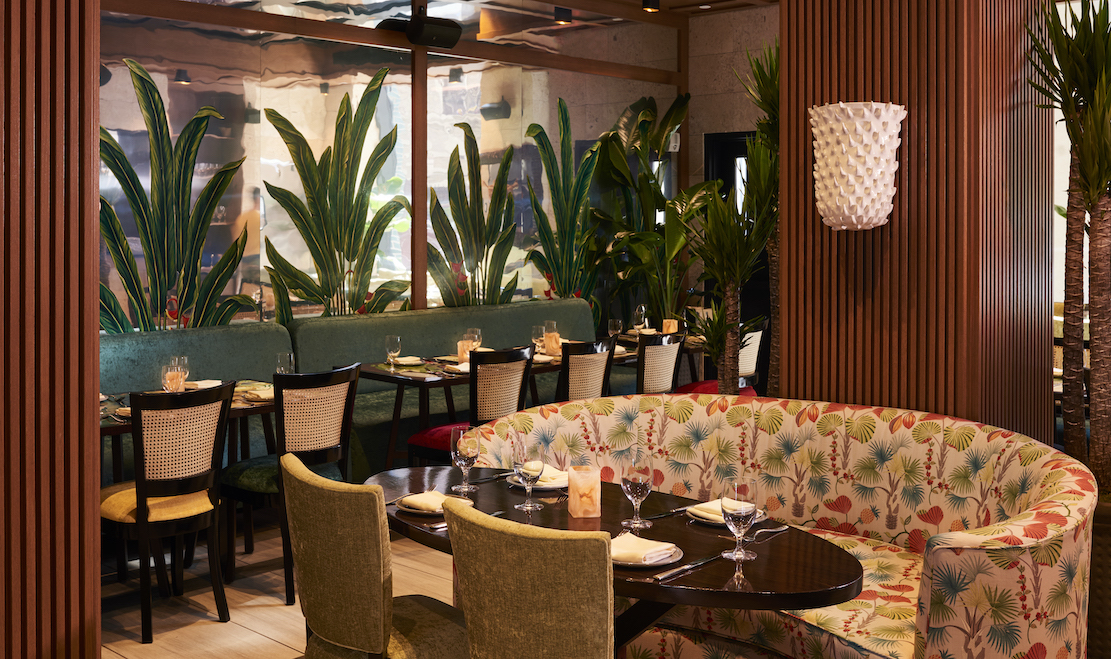 caldos
and salads, main dishes and items from the parilla
grill. There is, of course, a signature cocktail
list—the margarita with passion-fruit juice and
hibiscus-rosemary foam is worth trying—and the
collection of spirits is impressive. But I wish
the modest wine list had more Central and South
American bottlings.
caldos
and salads, main dishes and items from the parilla
grill. There is, of course, a signature cocktail
list—the margarita with passion-fruit juice and
hibiscus-rosemary foam is worth trying—and the
collection of spirits is impressive. But I wish
the modest wine list had more Central and South
American bottlings.
We
asked the chef to serve us family-style, so we
enjoyed a wide range of dishes, starting off with
a major hit in the chicharron y
casaba ($16) of amazingly crispy pork belly
boiled down and the heat turned up to make the
skin crunch, with sweet caramelized plantains and
a traditional savory, lime-tinged green sauce
called wasakaka.
Bombones de
yuca ($14)
are deep-fried pop-in-the-mouth balls of
cassava dough filled with cheddar that you dip
into a sauce of pineapple and chipotle. Very
tasty, juicy goat’s meat-filled croquets ($14) are
served with an avocado spuma.
pop-in-the-mouth balls of
cassava dough filled with cheddar that you dip
into a sauce of pineapple and chipotle. Very
tasty, juicy goat’s meat-filled croquets ($14) are
served with an avocado spuma.
This is rich food in every way,
workingman’s fare refined, so dishes may be shared
if you plan to order a lot from the menu.
By all means get the sancocho ($12
or $26), a hearty stew chock full of chicken,
beef, pork, root vegetables and an ear of corn (below),
served with white rice and avocado. The
other item to get for a table of two is the
dramatically presented pecao frito
($59), which is a deep-fried red snapper of
succulent chunks of the fish, cherry tomatoes and
red onion displayed arrayed within the fanned
fish’s bones. 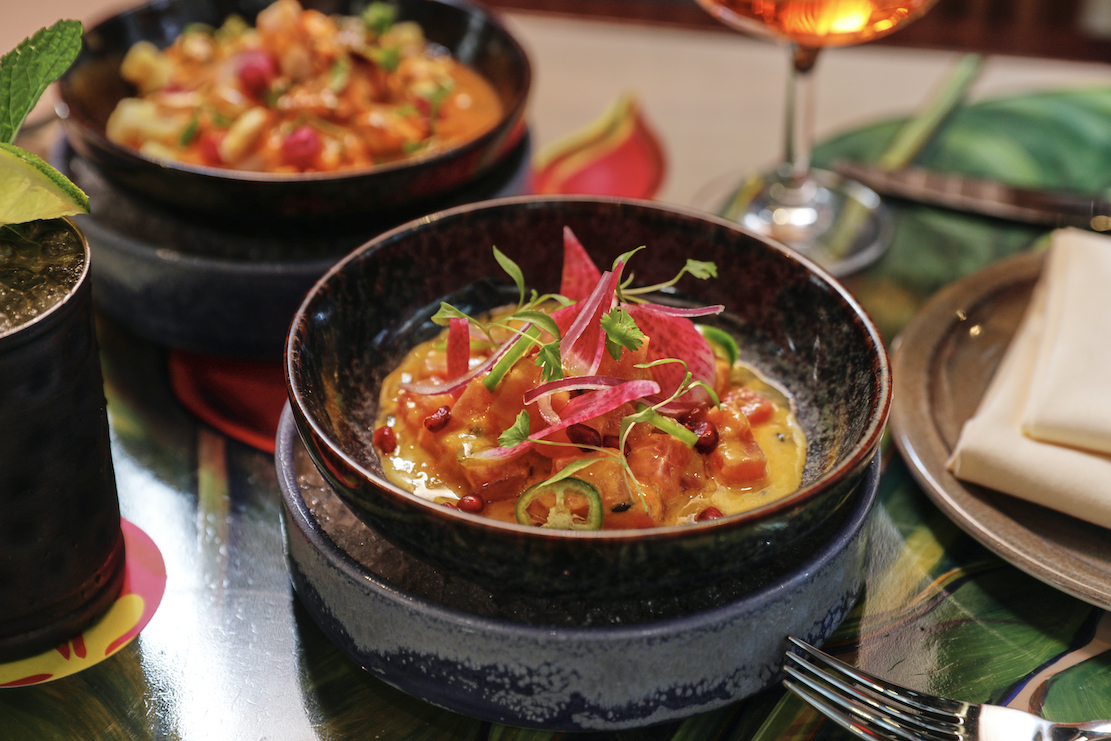
As befits a Caribbean restaurant, there are
grilled beef dishes done as churrascso.
Here they take a 14-ounce ribeye, sear it
perfectly, keeping the inside rosy red, and serve
it with a spicy chimichurri sauce. At $49 it’s a
great deal for a good deal of meat.
Desserts ($13) are as sumptuous as what
comes before, and I loved both the cinco
leches cake, and
the cinnamon-tinged majarete corn
custard
topped with ice cream.
Jalao
NYC is easy enough to get to from any point in
Manhattan, the Bronx, Westchester or eastern New
Jersey—it’s just north of the George Washington
Bridge, just south of Yeshiva University and just
west of the Harlem River—so if you’ve never had
this kind of food before I would make it a
requisite visit for any peripatetic gourmand. For
any Dominican in the area Jalao NYC is a terrific
emblem of the island’s food culture.
Open nightly for
dinner.
ANOTHER VERMEER

NOTE: Since there will be no issue of the Virtual Gourmet next week, I've provided readers with two combined chapters of Another Vermeer.
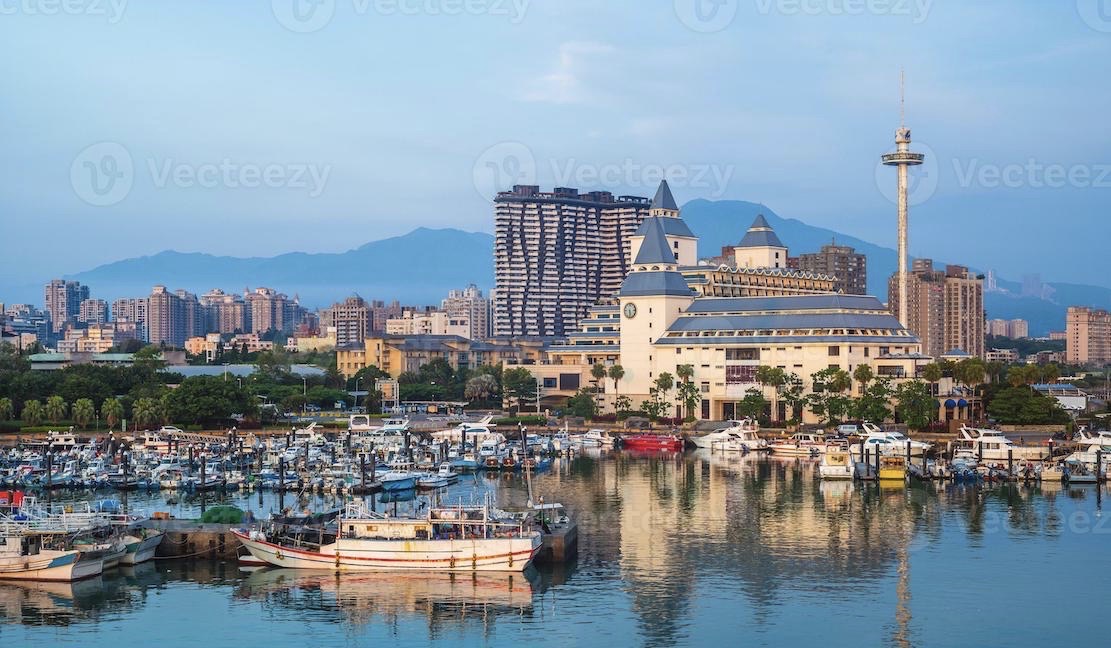
Taipei Dadaocheng Dock Area
The SUV pulled away
from the Shui Building parking lot
and headed away from the main street, going
down back roads and making many turns that
took advantage of traffic lights about to turn
red so as to prevent any suspicious cars from
following.
The Chinese were silent throughout the
trip until they arrived in the Dadaocheng dock
area of the city, where Guo gave them
directions to a slip far from the main part of
the port, then used his mobile phone to call
someone.
They arrived close to the end of an
isolated dock, where two men were getting a
trawler ready to depart, its engine still
quiet.
“Oh, no,” said Katie, “not another boat
ride!”
“I guess so,” said David, remembering a
similar sailing they took during the Capone
caper.
The Chinese thugs got into the boat
first, then Guanting and Guo, nudging Katie
and David forward, with the two boatmen
helping them aboard. The
Americans were ushered below decks, where it
was dark but with enough light from small
portholes for Katie and David to see.
After a few more minutes, Guanting and
Guo doffed their suit jackets in favor of life
jackets, which the crew members also wore.
None was offered to Katie and David.
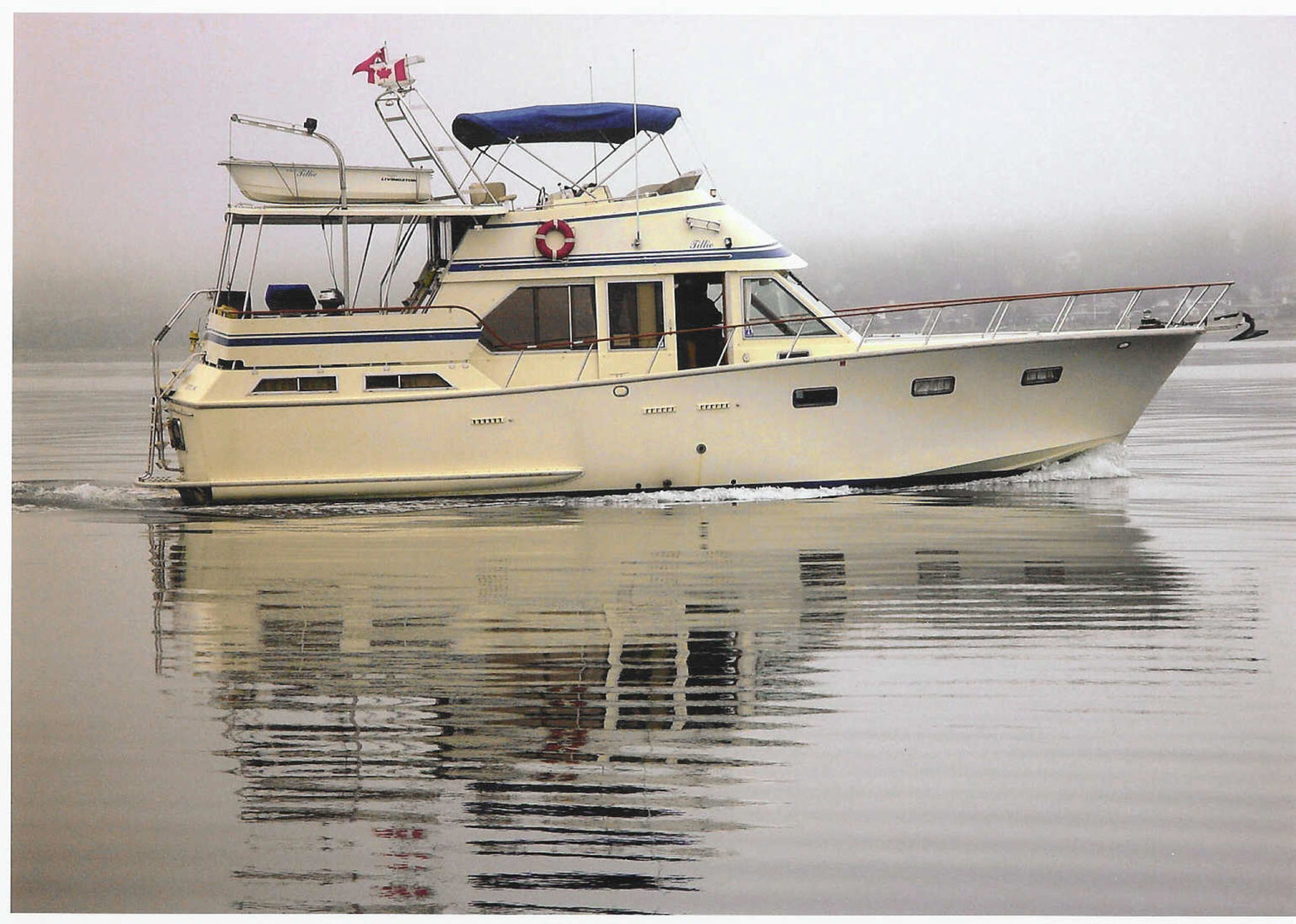 Hours
passed until twilight and darkness came on
fast. Finally the trawler was unhitched from
the dock, its lights on, and started sailing
slowly out of the harbor, then south into
Taiwan Strait. The captain of the trawler knew
not to sail beyond the twelve-nautical-mile
legal limit of Taiwan’s territorial waters,
where, only the year before, the Red Chinese
had launched test missiles to intimidate the
government of Taiwan prior to the 1996
elections.
Hours
passed until twilight and darkness came on
fast. Finally the trawler was unhitched from
the dock, its lights on, and started sailing
slowly out of the harbor, then south into
Taiwan Strait. The captain of the trawler knew
not to sail beyond the twelve-nautical-mile
legal limit of Taiwan’s territorial waters,
where, only the year before, the Red Chinese
had launched test missiles to intimidate the
government of Taiwan prior to the 1996
elections.
Nevertheless,
without Katie and David knowing it, Guo told
the captain to go several miles beyond the
limit, apparently to leave any evidence of any
crime in Red Chinese waters. He
also knew the Taiwan harbor police did not
patrol out that far.
As the boat got about six miles out,
the captain shut down its lights, with only
the dashboard lights in his cabin glowing.
There had been the sound of clanging buoys
earlier and Katie tried to stifle the thought
that they sounded like the knell of graveyard
bells. Now there was just the sound of the
lapping of the waves.
At first Katie said little to David,
watching his face trying to figure some way
out, but it all seemed futile.
“What would 007 do in a situation like
this?” she asked, feebly trying to sound
upbeat.
“Bond would punch all his captors out,
then shoot them with their own guns,” said
David, “but that’s because his idiot captors
never bothered to handcuff him. Instead
they’d give him one of his own cigarettes,
which blew up in their faces. Our
thugs are slightly smarter.”
“Any friendly whales in these waters?”
she asked, smiling weakly. David
smiled back but said nothing, then, “Fucking
Coleman.”
“I know,” said Katie. “It is
unbelievable that he would be one of Shui’s
stooges.”
“Well, now, let’s think back. Coleman
was eager to help us get an appointment with
Shui, right? And that was before
you alerted him to our theory about the
accidents?
What did he say when you told him?”
Katie thought back. “He sounded very
surprised, and when I asked him if he thought
I should bring it up with Shui, Coleman said
maybe he
should do it first, before we arrive in
Taiwan. That would have alerted Shui, but
Coleman didn’t know about Chin confessing to
the feds.
We only found that out this morning.
So, I’m thinking that Coleman maybe phoned
Shui to tell him that we had this theory but
no proof of anything. I refuse to believe John
would hand us over to be murdered by Shui.”
“Well,” said David, “remember one
thing: Who besides Kiley and us had the list
of six probable collectors?”
“John did.”
“And who did he get the list from?”
Katie swallowed hard. “From me. He
got it from me.”
“Exactly, so Shui got the list from
Coleman. Saito was already dead, and Shui
might well have guessed who his main
competitors would be, but the violent acts
have all been directed to the people
specifically on that list. That became the
kill list.”
“And only John could give it to him,”
said Katie. “Oh, my God!”
“Coleman suckered you, Katie, but
listen, it’s probable Coleman gave Shui the
list without any idea it would involve trying
to knock the collectors off or cripple them.
You never even told him anything about Lauden
and Chin beyond what he’d read in the papers.
“Coleman used the list for his own
purposes, which, as it turned out, was to
compromise everyone on it, under orders from
Shui. Then
he gets invited first class to Taiwan by Shui,
and Coleman goes light on him in the article. I’m
pretty sure that was the extent of Coleman’s
involvement. I don’t think he shared our
theory until you told it to him a few days
ago.”
“So, you don’t think he knew Shui would
try to murder us in the hotel?”
“I dunno,” said David. “It’s very, very
tough for me to believe that. Coleman’s
not the type. I think he was just warning his
Taiwanese benefactor to be careful during the
interview because we had this theory about
Shui’s involvement.”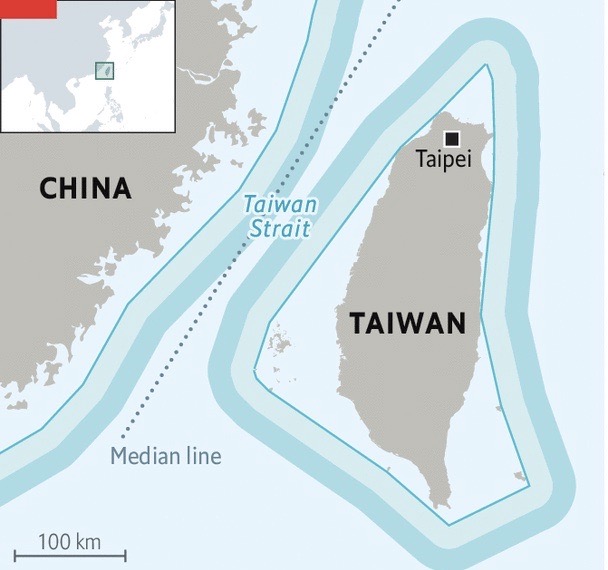
“God, I hope you’re right, David. But
he’s still a bastard.”
“And he’s probably going to be indicted
as an accessory, if the feds can prove it. I’m
sure he’ll spill everything he knows and plead
that he is innocent about the criminal part of
the deal.”
“Well, he’s sure as shit going to be
fired and never work in journalism again. But
I wanna see the little bastard get put away.”
Guo came down to see his captives.
“How much longer we going to be on this
piece of junk?” asked David.
“This is not a junk,” said Guo. “It’s a
trawler. Junks have big sails.”
“I don’t give a rat’s ass,” said David.
“How much longer to get wherever the hell it
is we’re going?”
“You should be happy we are still
moving. It
means you are still alive. But it will not be
long now.”
With that Guo called the two crew
members and said something in Chinese that
caused them to bring down four sand bags,
looking to weigh about ten pounds each.
Katie let out a scream. David cursed at
Guo, who slapped him across the face. Then
the two crewmen began tying the sandbags on
each leg of their captives. Katie was
panic-stricken, wailing. David
tried to calm her down but she just kept
looking at the sandbags and kicking her feet
in a futile struggle. Finally
the tying up was done and the crewmen went
back up on deck.
Oddly enough, David was thinking about
how this method of killing an enemy had long
been used by the mobsters he chased back in
New York, and how the NYPD had dragged the
waters around Manhattan and Brooklyn, only to
find rotted corpses fed on by the fish.
Nothing he’d ever seen all his years on the
job ever prepared him for that sight, and he
started to hyperventilate.
“David, what’s the matter?” screamed
Katie, thinking her only hope was having a
heart attack.
“S’okay, s’okay, I’m okay now,” he
said, calming himself down. “Katie, I just
want you to know, that after everything we’ve
been through, I’m crazy about you.”
“I love you too, David. You’ve been
like a big brother to me.”
That was not what David was hoping to
hear, but before he could say anything else,
the night’s silence was broken by the
startling loud blast of a fog horn, followed
by the whooping sounds of what David
recognized as a police boat.
“What’s that?” asked Katie, her eyes as
wide as they could open.
“It’s a police boat! It’s
a fucking police boat!”
For a brief, irrational moment David
imagined it would be his cop friend Bobby Bao
riding the prow of a Taipei police boat, or
maybe Gerry Kiley with a squad of Interpol
cops. The
sound of the whoops and the boat’s motor were
getting closer very fast, and Katie and David
heard a man speaking Chinese loudly through a
bullhorn.
They
also saw Guo, Guanting and the crewmen of the
trawler scrambling. Guo
was clearly telling the others to get the
Americans from below decks and throw them into
the sea as quickly as possible, but both Katie
and David used all their strength and
adrenaline to kick back. Then they heard the
crack of a rifle coming from the police boat
and more shouts through the bullhorn. A
moment later, they felt the police boat hit
the side of the trawler hard enough to knock
everyone onboard down.
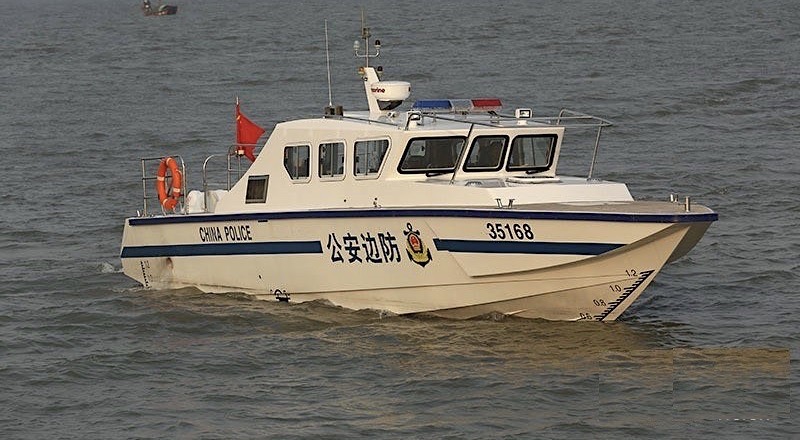 More
Chinese shouts, another rifle shot, and the
men on the trawler put their hands up, having
failed to get Katie and David off the boat.
Then there was the sound of men boarding the
trawler, speaking Chinese forcefully and
rapidly.
Guo, Guonting and the crew got down on
their stomachs, and David could just see the
police standing over them with what looked
like MP5 semi-automatic guns.
More
Chinese shouts, another rifle shot, and the
men on the trawler put their hands up, having
failed to get Katie and David off the boat.
Then there was the sound of men boarding the
trawler, speaking Chinese forcefully and
rapidly.
Guo, Guonting and the crew got down on
their stomachs, and David could just see the
police standing over them with what looked
like MP5 semi-automatic guns.
The police aimed the rifles below decks
until they heard Katie and David shout,
“Americans! Don’t shoot!” raising their hands
high above their heads. An
officer descended and told his men to untie
the sandbags but to leave the handcuffs for
the time being.
“Do any of you speak English?” asked
Katie. One of the younger policemen said, “I
speak little.”
“Thank God, listen”—she spoke very
clearly and as calmly as she could—“these men
kidnapped us in Taipei and were going to kill
us. Throw us into the ocean.”
The policeman didn’t answer but told
the officer what he heard. The
officer nodded, spoke back, and soon they were
brought aboard the sleek and obviously very
fast police boat. Katie and David, still in
cuffs, motioned to the officer to have them
removed, which he did. The
two Americans rubbed their wrists, which
showed considerable chafing.
“Sheh-sheh,” said Katie, approximating
the sounds of xièxiè,
“thank you.” David gave the word a try, too,
then, his hands free, David went up to Guo and
smashed a fist into his face, breaking the
man’s nose.
“That’s for shoving my friend to the
ground back on land.”
The police pulled David away but
released him.
Order restored, the four men were
brought below decks and locked in a very
small, cramped cell.
“So you are the Taipei harbor police?”
asked Katie.
The officer looked at his younger
colleague, who translated then said, “No, no,
we not Taipei. We Hong Kong. Hong Kong.”
David looked at Katie and said, “Hong
Kong? How far away from Taipei could we be?”
The young policeman struggled to say,
“You cross line, too far, too far. This China
water. No Taiwan water.” Then he pointed
towards a red, white and blue flag of the
Chinese maritime police and the words ‘HONG
KONG” printed below Chinese characters on the
boat’s tower.
“See, Hong Kong.”
So Katie and David had been rescued by
the Hong Kong maritime police, apparently
because they were in what they claimed were
the sovereign waters of the People’s Republic
of China. The policeman continued: “We go back
Hong Kong. You talk there.”
“Something tells me we are out of the
frying pan and into the fire,” said Katie.
“Maybe, maybe not,” said David. “We’re
just going to have to wait and see. Any
idea how far Hong Kong is from where we are?”
“Not close. I’d say, like 500 nautical
miles.”
“We’re going to sail 500 miles on this
boat?”
His question was answered by the young
policeman, who told them as best he could that
another larger boat was coming in a few hours
and they would be transferred to that and on
to Hong Kong but the next evening. The
Americans were offered some tea and rice, and
within three hours sailing southwest, the
police boat met the much larger vessel.
After being checked out by the ship’s
medical personnel, who spoke English, Katie
and David were given separate cabins and told
they would be in Hong Kong the following day.
“You will be interviewed in the morning
before we land. Meanwhile, we will take your
passports, if you please. They
will be returned in Hong Kong.”
Katie was bold enough to ask, “Is there
any way we could make calls to the United
States?”
“Perhaps later. Not
until you have your interview and we learn
details of what happened tonight.”
“We’d be happy to tell you right now,”
said David, fending off post-adrenaline
fatigue and the aches from being bound for so
long.
“Tomorrow morning,” the man said, got
up and walked off.
“Everyone’s got his own protocol,” said
David to Katie. “I guess this is what they
call a slow boat to China. Guess the only
thing to do is get a good night’s sleep.”
“I think that is going to be very
easy,” said Katie, who was already yawning. Within
a half hour, after showers and fresh
clothes—Katie fit quite well into a sailor’s
white fatigues—that were in their rooms. As
soon as she put her head on the pillow, her
eyes closed. Then she bolted straight up and
screamed, “Damnit! That
bastard Guo has my tape recorder!”
© John Mariani, 2016
❖❖❖
FOURTH EDITION OF
THE COMPLETE BORDEAUX
By John Mariani
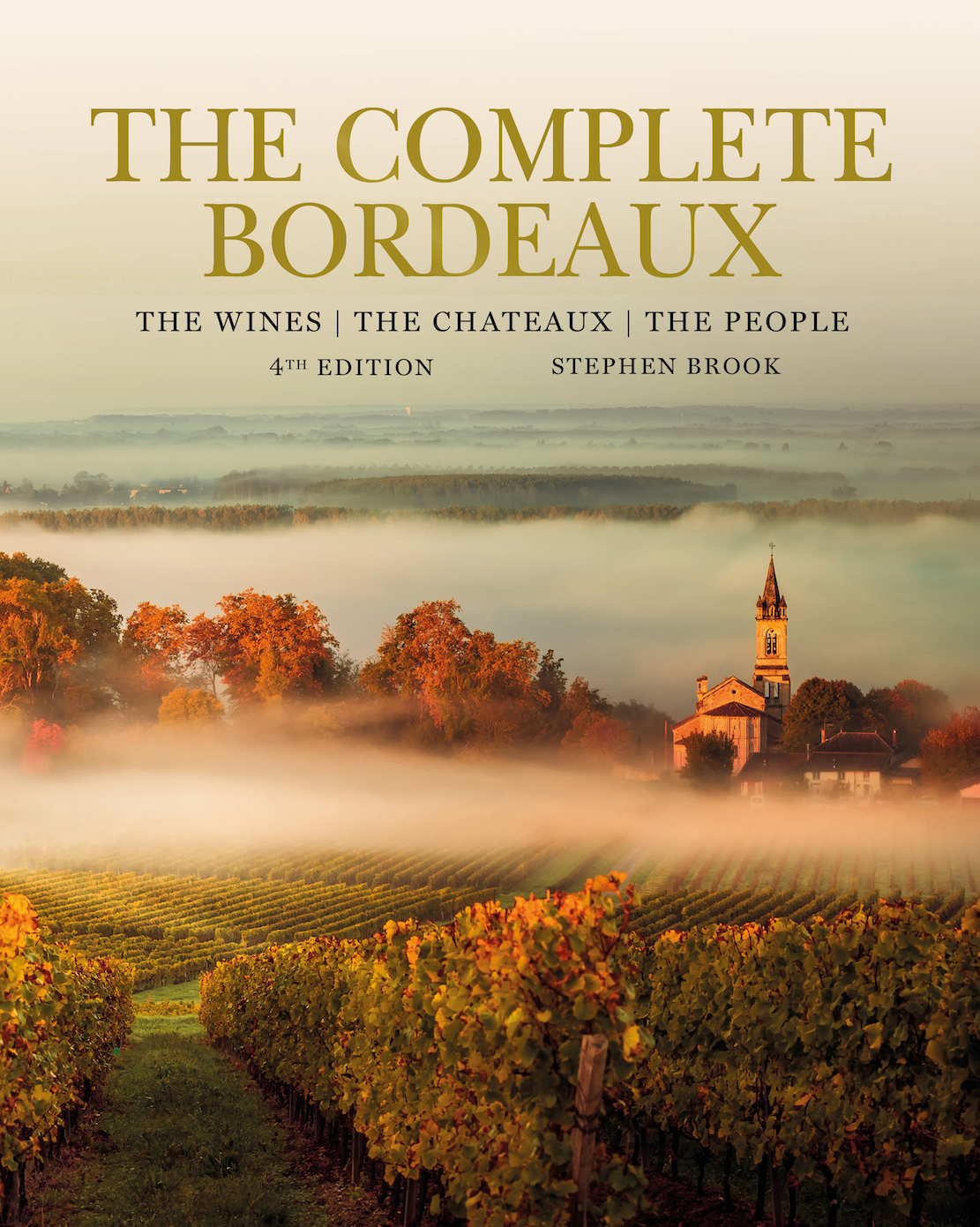
A major
overhaul, delayed by Covid for two years, of The Complete
Bordeaux: The Wines, The Chateaux, The People by
Stephen Brook (Mitchell Beazley, $75) comes at a
time of upheaval in French vineyards, given
changes in global markets, climate change and
agro-tourism. I posed questions to Brooks about
this latest edition.
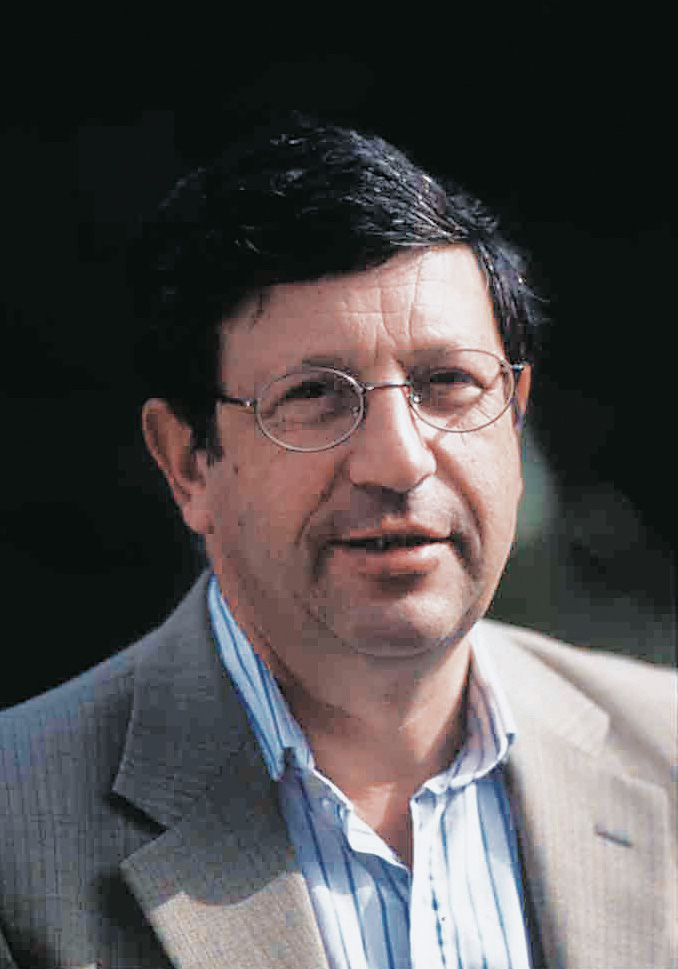 This is the
4th edition. What is different now?
This is the
4th edition. What is different now?
Five years is a long time
in Bordeaux. There are numerous changes in
ownership, as well as changes in generation. The
celebrated consultants, such as Michel Rolland, are
still around, but being supplemented by a new crop
of younger experts who may be more adept at dealing
with issues such as climate change. There has been a
remarkable expansion in organic and biodynamic
farming, as proprietors are urged to take greater
account of environmental concerns. Sauternes, long
seen as a perfect way to lose money, is undergoing a
revolution, as new entrepreneurs buy estates and
transform them, creating hotels, and reducing the
production of sweet wines to reflect the limited
demand while expanding production of dry white
wines. So plenty to write about, not to mention a
succession of fine new vintages.
As someone who wrote
five editions of The
Encyclopedia of American Food & Drink, I
doubt there will ever be another, because looking
up the entries within can just as easily, if not
as dependably, find a great deal of information
online. Is this the future or the fate of books
like yours?
Yes, that's quite likely.
For some years I revised Hugh Johnson's
Wine Companion, essentially an encyclopedia of
wine, but new editions ceased as potential
purchasers realized they could find much of the same
information on websites. The Complete
Bordeaux is different, in that I voice
opinions too. The content is not solely factual.
Also I am 100% independent, whereas chateau websites
clearly have an agenda. Nonetheless, I doubt there
will be many more editions!
You write that Covid
prevented you from visiting Bordeaux in 2021. How
did you handle that gap?
I was fortunate, in having
good contacts with growers' associations in all
parts of Bordeaux, and similar contacts with
groupings such as the Alliance des Crus Bourgeois,
and with merchants and consultants. Without
exception, they responded to my requests for samples
of recent vintages, so I was able to taste hundreds
of wines here in London. There were also many Zoom
calls with producers and winemakers.
You write that,
unlike the wineries of Napa Valley, Barossa Valley
and Burgundy, the Bordeaux vintners all seem
reluctant to have visitors and do not communicate
well with the public. And that it’s getting worse,
even among vintners you visited in the past. Why
is this?
When I started visiting
Bordeaux in the mid-1980s, a phone call to a chateau
was usually sufficient to result in a visit and
tasting. That's because there were relatively few
visitors. Now, wine lovers descend on Bordeaux from
all over the world, and few chateaux have the
facilities to welcome hundreds of visitors each day.
Some properties (e.g., Lynch
Bages) have always welcomed visitors (mostly by
appointment) and properties in less prestigious
areas, such as Fronsac or Graves, are often pleased
to accept visitors for a visit and tasting. Bear in
mind that the weather is clement year round in Napa
or much of Australia, whereas in Bordeaux the
climate is miserable from November to March, making
it very costly to maintain staff and infrastructure
for visitors when very few are around.
You write that "we
the privileged," meaning people in the trade and
authors like yourself, have access to staying at
the châteaux. How does this generosity affect your
response to what they are offering you to drink?
I think the honest answer
is yes. Over many decades it’s inevitable that
certain proprietors become friends. Not just because
they invariably agree to a visit or request for
samples, but because they are valued as reliable
sources of information. Some owners court the press
by toadying to them, but others (such as Olivier
Bernard at Chevalier) see the value of two-way
communication. But I have never been leaned on to
provide a glowing review or tasting note, and I have
never 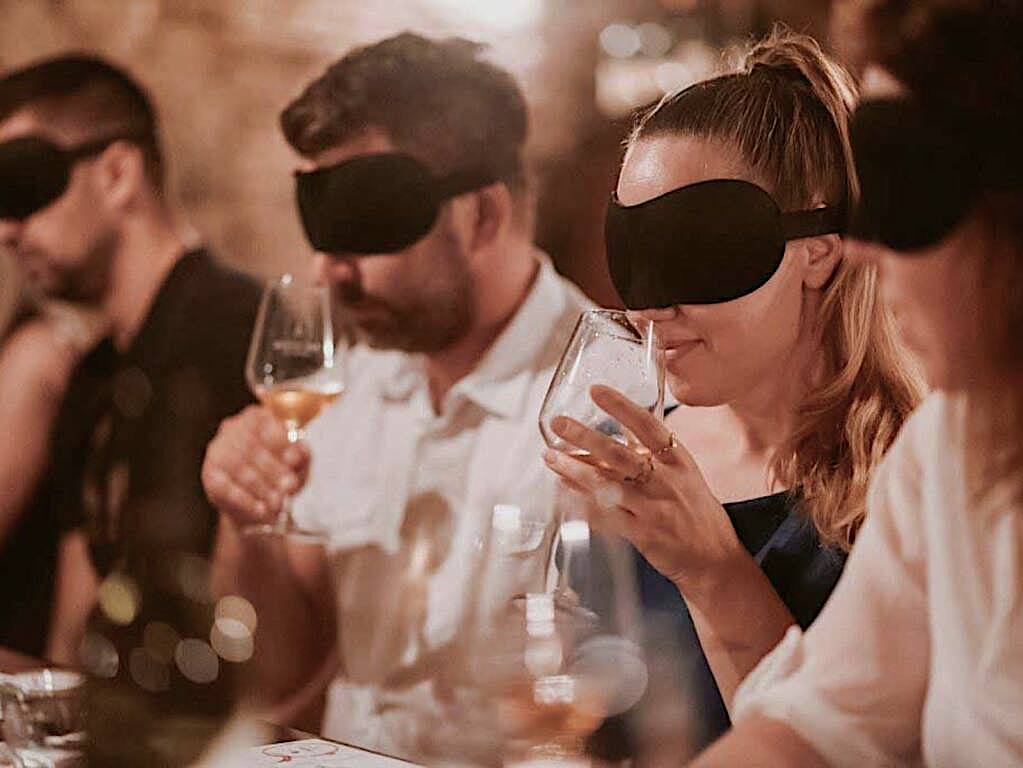 hesitated to
express disappointment, even from estates I respect.
hesitated to
express disappointment, even from estates I respect.
Do you always taste
your wines blind?
During the UGC primeur
tastings the press can choose to taste blind or not
blind. I always tasted blind. But more and more
chateaux insist on a personal visit to taste, so
tasting blind isn't an option. I also participate in
wine competitions, where the wines are tasted blind.
It's a tricky issue, especially during primeurs,
when you aren't tasting a finished wine. I recall
tasting a wine blind that turned out to be
Lynch-Bages. It showed poorly, so I retasted the
wine non-blind, and can defend doing so. Some
samples are defective, and even the finest palate
can show signs of fatigue resulting in poor judgment
from time to time. I have always refused to score
primeur wines (too young and unfinished, and you
don't know how the sample has been assembled), so
for me it's not a major issue.
You write that many
Bordeaux vintners do a form of filtering their
wines but in answer to the question do they
filter, they say no. Please explain.
Filtration has varying
degrees of severity. A sterile filtration can be
damaging to a wine, whereas a coarse filtration
(known, I think, in the New World as a "rocks and
frogs" filtration) primarily seeks to remove any
solids that remain after racking. But I'm not
dogmatic about this. If a winemaker is convinced a
wine needs filtration to be presentable, I'll accept
that judgment. Routine sterile filtration is more of
an issue with high-volume wines that need to be
consistent and acceptable to consumers who don't
understand (why should they?) that wine can throw a
natural deposit.
You write that it is
more or less useless to speak about barrels used
and how they have been toasted because the nuances
can be so small. So you have chosen not to speak
about which barrels are used. Correct?
It's beyond my expertise to
determine whether a wine has a certain character or
quality because the winemaker chose Taransaud rather
than Darnajou barrels. Moreover, many winemakers at
top chateaux hand-commssion and hand-select their
barrels. So Ch X’s Taransaud may well differ from Ch
Y's. Moreover, it’s almost impossible for a
journalist to know which barrels made it into the
final blend. Tasting the same wine from different
barrels can be a fascinating exercise for
professionals, but I think consumers are rightly
more interested in the final product.
How does your book
on Bordeaux differ from those written by Robert
Parker, Michael Broadbent, Neil Martin and Jane
Hansen? You say that bottles can vary widely and
that some are even fakes provided to the wine
writers. Does this make
tasting notes, based on one bottle, useless?
One major difference is
that I don't score wines in my book, though I do
provide tasting notes. I'm not interested in ranking
wines. Clearly, I need to assess their style and
quality, and I dare say some personal preferences
come through. It's not really for me to say whether
my books are more reliable or more informative than
those of my fellow writers! Bottle variation is only
a real problem with cask samples, which can easily
be manipulated to subdue tannins or make them more
appealing in their youth (when initial scores are
bestowed). And, of course, bottles of ancient wines
can and do vary. For wines within 10 years of the
vintage it's not really an issue.
At a time of PC
correctness have you taken any heat for calling
Bordeaux “virile" wines?
I don't think so. I do try
to avoid terms such as 'feminine,’ often used to
describe Margaux wines. But a young Medoc from a
good property can, I think, usefully be described as
virile or muscular.
How has climate
change affected Bordeaux and what do you see in
the next 10 years of change?
A big question! And it's
one I address in my introductory chapters. There are
wines from 2010 and 2018 with 15.5% alcohol. That
may be fine in Barossa or Paso Robles, but it robs
Bordeaux of its typicity. Most chateaux are well
aware of this, and are making changes to farming and
yields, so as to achieve full ripeness at lower
sugar, and thus alcohol, levels. But I’s not easy to
do. Conversely, climate change has benefitted areas
such as Castillon or Francs, where
grapes use to struggle to ripen. Today that is
rarely an issue, resulting in greatly improved
wines. The authorities are now permitting the
planting of alternative varieties, but it will be
many years before they become significant components
of major wines. This, too, is something I address in
my book.
It seems that this
book would take up an enormous amount of your
time. Are you already working on a fifth edition? I have written more than
40 books on many topics not about wine. I'm not
actively working on a new editio—give me a
break!—but I continue to taste Bordeaux whenever the
opportunity presents itself, so as to keep my data
base up to date. And I hope I return to the region
next year.
❖❖❖
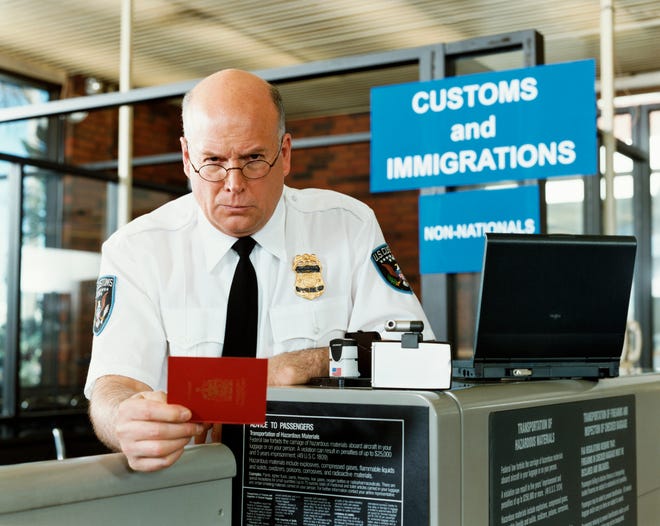
SOME GIRLS HAVE ALL THE
LUCK
“I Went on a Honeymoon Holiday to
Santorini—by Myself” by Olivia Petter, London
Times (10/6/22).
❖❖❖
Any of John Mariani's books below may be ordered from amazon.com.
 The Hound in Heaven
(21st Century Lion Books) is a novella, and
for anyone who loves dogs, Christmas, romance,
inspiration, even the supernatural, I hope you'll find
this to be a treasured favorite. The story
concerns how, after a New England teacher, his wife and
their two daughters adopt a stray puppy found in their
barn in northern Maine, their lives seem full of promise.
But when tragedy strikes, their wonderful dog Lazarus and
the spirit of Christmas are the only things that may bring
his master back from the edge of despair.
The Hound in Heaven
(21st Century Lion Books) is a novella, and
for anyone who loves dogs, Christmas, romance,
inspiration, even the supernatural, I hope you'll find
this to be a treasured favorite. The story
concerns how, after a New England teacher, his wife and
their two daughters adopt a stray puppy found in their
barn in northern Maine, their lives seem full of promise.
But when tragedy strikes, their wonderful dog Lazarus and
the spirit of Christmas are the only things that may bring
his master back from the edge of despair. WATCH THE VIDEO!
“What a huge surprise turn this story took! I was completely stunned! I truly enjoyed this book and its message.” – Actress Ali MacGraw
“He had me at Page One. The amount of heart, human insight, soul searching, and deft literary strength that John Mariani pours into this airtight novella is vertigo-inducing. Perhaps ‘wow’ would be the best comment.” – James Dalessandro, author of Bohemian Heart and 1906.
“John Mariani’s Hound in Heaven starts with a well-painted portrayal of an American family, along with the requisite dog. A surprise event flips the action of the novel and captures us for a voyage leading to a hopeful and heart-warming message. A page turning, one sitting read, it’s the perfect antidote for the winter and promotion of holiday celebration.” – Ann Pearlman, author of The Christmas Cookie Club and A Gift for my Sister.
“John Mariani’s concise, achingly beautiful novella pulls a literary rabbit out of a hat – a mash-up of the cosmic and the intimate, the tragic and the heart-warming – a Christmas tale for all ages, and all faiths. Read it to your children, read it to yourself… but read it. Early and often. Highly recommended.” – Jay Bonansinga, New York Times bestselling author of Pinkerton’s War, The Sinking of The Eastland, and The Walking Dead: The Road To Woodbury.
“Amazing things happen when you open your heart to an animal. The Hound in Heaven delivers a powerful story of healing that is forged in the spiritual relationship between a man and his best friend. The book brings a message of hope that can enrich our images of family, love, and loss.” – Dr. Barbara Royal, author of The Royal Treatment.
 |
The Encyclopedia of American Food and Drink by John F. Mariani (Bloomsbury USA, $35) Modesty forbids me to praise my own new book, but let me proudly say that it is an extensive revision of the 4th edition that appeared more than a decade ago, before locavores, molecular cuisine, modernist cuisine, the Food Network and so much more, now included. Word origins have been completely updated, as have per capita consumption and production stats. Most important, for the first time since publication in the 1980s, the book includes more than 100 biographies of Americans who have changed the way we cook, eat and drink -- from Fannie Farmer and Julia Child to Robert Mondavi and Thomas Keller. "This book is amazing! It has entries for everything from `abalone' to `zwieback,' plus more than 500 recipes for classic American dishes and drinks."--Devra First, The Boston Globe. "Much needed in any kitchen library."--Bon Appetit. |
"Eating Italian will never be the same after reading John Mariani's entertaining and savory gastronomical history of the cuisine of Italy and how it won over appetites worldwide. . . . This book is such a tasteful narrative that it will literally make you hungry for Italian food and arouse your appetite for gastronomical history."--Don Oldenburg, USA Today. "Italian
restaurants--some good, some glitzy--far
outnumber their French rivals. Many of
these establishments are zestfully described
in How Italian Food Conquered the World, an
entertaining and fact-filled chronicle by
food-and-wine correspondent John F.
Mariani."--Aram Bakshian Jr., Wall Street
Journal.
"Equal parts
history, sociology, gastronomy, and just
plain fun, How Italian Food Conquered the
World tells the captivating and delicious
story of the (let's face it) everybody's
favorite cuisine with clarity, verve and
more than one surprise."--Colman Andrews,
editorial director of The Daily
Meal.com. "A fantastic and fascinating
read, covering everything from the influence
of Venice's spice trade to the impact of
Italian immigrants in America and the
evolution of alta cucina. This book will
serve as a terrific resource to anyone
interested in the real story of Italian
food."--Mary Ann Esposito, host of PBS-TV's
Ciao
Italia. "John Mariani has written the
definitive history of how Italians won their
way into our hearts, minds, and
stomachs. It's a story of pleasure over
pomp and taste over technique."--Danny Meyer,
owner of NYC restaurants Union Square
Cafe, The Modern, and Maialino.
|
 |
 |
 |
 |
 |
 |
 Everett Potter's Travel Report:
Everett Potter's Travel Report: 
 Eating Las
Vegas
Eating Las
Vegas
MARIANI'S VIRTUAL GOURMET
NEWSLETTER is published weekly. Publisher: John Mariani. Editor: Walter Bagley. Contributing Writers: Christopher
Mariani, Misha Mariani, John A. Curtas, Gerry Dawes, Geoff Kalish.
Contributing
Photographer: Galina Dargery. Technical
Advisor: Gerry
McLoughlin.
If you wish to subscribe to this
newsletter, please click here: http://www.johnmariani.com/subscribe/index.html
© copyright John Mariani 2022
